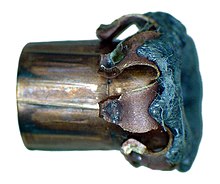A-Square Shock Power Index
The A-Square Shock Power Index (abbreviated ASPI) or A-Square Power Index is an index for identifying the impact of a projectile . It is based on the quantities energy and cross-section and therefore only represents impact ballistics, but not internal, external or even wound canal ballistics . The projectile properties and effects are therefore not described.
history
The complex processes involved in hitting a projectile on a target are difficult to grasp. This is due to the complex mathematics and the limits of numerical simulation ( FEM , BEM ), but also to the lack of the necessary material parameters in these areas. In addition, it is usually unclear beforehand what and where exactly will be hit. Thus, the assumptions to be made for a calculation are very extensive.
Attempts were made early on to describe the effect of a projectile and the protection against it in a simplified mathematical and physical way. Newton and his calculation of the penetration force or the armor formula are mentioned here.
The ASPI was developed by Colonel Arthur Brent Alphin from his military experience with the stopping action of various calibres. Alphin was the founder and developer of the American ammunition manufacturer A-Square Company , which went bankrupt in 2001 and was taken over by James L. Smith. Alphin has been the technical director ever since. In his book Any Shot you want , published in 1996, Alphin presented a system of indicators with a variant of the penetration index to make the performance of calibers comparable.
meaning
Key figures such as ASPI are particularly important for the police, self-protection and hunting. It is important for hunters to kill the game as gently and without suffering as possible. For this, on the one hand the hit position is decisive, on the other hand the impact of the projectile. This is legally regulated in Germany in the Federal Hunting Act. However, only minimum calibers and minimum energies are mentioned here. As a rule, hunters seek greater certainty in the choice of caliber.
In practice, therefore, various recommendations are made that are based on practical experience. The ASPI at least essentially reflects this.
The ASPI does not reflect the effect of the caliber with regard to e.g. B. Distraction of small calibers by branches, wound ballistics or the effects of the projectile type .
Calculation and use
The calculation of the ASPI is as follows:
with as kinetic energy of the projectile
and as the radius of the projectile
With
and as the mass of the projectile
and as the speed of the projectile.
Since energy and speed decrease over the ballistic trajectory, in practice it is assumed as muzzle energy or muzzle velocity and remains within reasonable ranges of the target.
Unfortunately, only tables based on the Anglo-Saxon system of inches and foot-pounds instead of millimeters and joules have been published . Thus, ASPI of 200 corresponds ft * lb * in ² (minimum value to wild ) about 170-180 kJmm² in the metric system. In its publications, however, Alphin uses values from unspecified loads ( or remains unknown), which means that, in addition to the purely metric conversion, a correction factor of around 1.3 can be assumed.
In the file ASPI metrisch exemplary metric ASPI values (Jmm²) are compiled. These are based on the specified diameter of the bullets of a caliber and the specified muzzle energies and velocities. Manufacturer values were used for some calibres due to the lack of published specifications.
Thus, for stand hunting and game on wild a stronger 7 x 57 mm considered suitable (ASPI ft 157 * in² lb *, metric 120-132 kJmm²) for a driven hunt but is strongly a 8 x 57 mm (ASPI 237 ft * lb * in², metric 191–218 kJmm²) recommended. For further recommendations see jasw.de.
The practice with regard to the ASPI is thus well above the corresponding legal requirements of § 19 BJagdG : It is forbidden to hunt roe deer with a size below 1000J, for other hoofed game it is forbidden to hunt with a caliber below 6.5mm and below 2000J . Assuming the usual energy loss of commercially available ammunition from on, the result is a reference ASPI for roe deer of 34 kJmm², for the rest of the hoofed game of 88 kJmm². In terms of hunting practice and fairness to hunts , the above-mentioned ASPI values must at least be achieved, especially with driven hunts and other negative influences on the hit seat. A .223 Remington achieves the legal values, but it can be distracted if there are obstacles (branches, twigs, grass) or the weather (wind, rain). It achieves an ASPI that is comparable to a weak .357 Magnum or .40 S&W , which are normally only used to catch sick game. .308 Winchester or 7 × 57 mm are more suitable on roe deer.
Web links
- A-SQUARERIFLES and AMMUNITION ( Memento from June 19, 2013 in the web archive archive.today )
Individual evidence
- ↑ Ulfhere: The Mechanics of Terminal Ballistics , accessed April 6, 2018.
- ^ Norbert Hansen Penetration Index & Energy , accessed April 6, 2018.
- ↑ Biography: Arthur Alphin and Deutsches Jagd Lexikon, entry: Arthur Alpin , accessed on April 6, 2018.
- ↑ a b Caliber and bullet selection ( memento from May 11, 2013 in the Internet Archive ) at jasw.de, accessed on April 6, 2018.
- ↑ HUNTING AMMUNITION & HUNTING BULLETS ( Memento from May 22, 2013 in the Internet Archive ) at langmaack.com, accessed on April 6, 2018.
- ↑ Federal Hunting Act §19, paragraph 2 , accessed on April 6, 2018.
- ↑ Lutz Möller: Ballistics, surface load , accessed on April 6, 2018.
- ↑ a b Weapon and caliber selection after shock effect ( memento from October 20, 2012 in the Internet Archive ) at jasw.de, accessed on April 6, 2018.













